How He Fared in 2009: Roger Federer Slams It Into High Gear
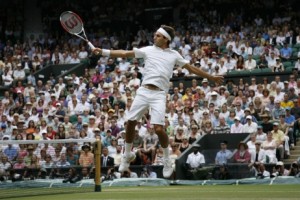
2009 was a record setting year for Roger Federer.
Memorable. Historic. Record-breaking. Personal best.
That is how you describe Roger Federer’s 2009 season. Roger was married to his long-time partner Mirka Vavrinec, and together they had twin daughters Myla Rose and Charlene Riva—oh, yes, and he played some tennis on his way to the top of the record books…
Leg No. 1—2009 Australian Open
Unlike 2008, when the world expected Federer to complete his life’s work, 2009 began with reservations about Federer’s abilities, his resolve, and his competitive fire.
Their suspicions were quickly confirmed as Andy Murray sustained his seeming domination of Federer first at Abu Dhabi, 6-4, 2-6, 6-7, followed quickly at Doha at the Qatar Exxon Mobil Open, 7-6, 2-6, 2-6. The Swiss fell to the unshakable Scot both times in semifinal contests.
Since losing to Federer in the finals at the 2008 U.S. Open, Murray had scored three consecutive victories against the former world No. 1.
In fact, Murray was so hot that the press anointed him the winner of the Australian Open before it began, much to the chagrin of reigning champion Novak Djokovic and Murray’s foil of late, Federer.
With a victory at Kooyong, Federer’s traditional warm-up tournament before the Australian Open, Federer entered Melbourne with a great attitude and a favorable draw because Murray was in Rafael Nadal’s half meaning that should the Scot make it that far, Federer could only meet him in the finals.
Federer, moreover, had supreme confidence in his ability to win once he stepped onto the court in a major final.
For Federer, though, his chief rival remained Nadal. It was the Spaniard who seemed to rise time after time to defeat Federer with a game the Swiss could seldom equal in the slams where Federer’s desire was the greatest.
But hard courts were not Nadal’s forte. In fact, conquering the hard courts in majors seemed only a remote possibility for the Spaniard seeded No. 1 at the 2009 Australian Open.
No one seemed to give Nadal a chance. All the talk centered on Murray, then Federer and Djokovic who faded quickly because of poor training and excessive heat according to those reporting on his fate.
Federer made his way through his side of the draw tested by Tomas Berdych after falling behind 0-2 in the fourth round. The Swiss found his game and won the remaining three sets to advance to the quarterfinals where he embarrassed Argentine Juan Martin del Potro, 6-3, 6-0, 6-0.
Nadal surprised everyone by surviving a grueling semifinal match with another left-handed Spaniard, Fernando Verdasco. In the finals against Nadal, it appeared that Federer could rarely quell his nerves or dictate points when he needed to at critical junctures.
Federer, however, had moments in the match when he was clearly playing superior tennis to the Spaniard. In the second and fourth sets Federer set the pace and dominated, winning those sets convincingly against the mighty Nadal.
The same could not be said of the first set which seemed to seesaw dominant play. The tide turned when the score stood at 5-5. Federer began to rush play, trying to shorten points instead of carefully constructing them. Nadal reverted back to type, playing careful, cautious, error-free tennis.
Simply put, Federer self-destructed at the end of the first set.
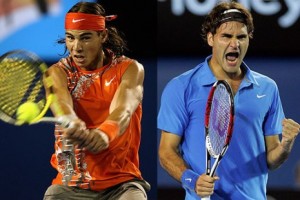
Federer couldn't pull out victory against Nadal at the Australian Open.
In the third set Nadal began being very aggressive. He ran Federer from side to side, dictating play. But Federer held on.
Finally, once again at 5-5, Federer had many break opportunities as Nadal suffered from unforced errors and less than stellar play. But Federer played too conservatively and let Nadal back into the match.
In the tie-break, Federer made four unforced errors and lost, 3-7.
In the fifth and final set both men were exhausted. Federer lost his concentration. Nadal recalled his old game, staying back, dictating play from the baseline with careful and deliberate placement and patience, endless patience.
Federer on the other hand reverted back to rushing, trying to hit instant winners, failing to recognize Nadal’s vulnerability sitting back on the baseline.
Nadal was literally running on fumes but the Swiss maestro did not see it and take advantage. His mental acumen on this day was not great enough to stop Nadal from seizing the Australian Open from Federer and denying him his 14th Grand Slam title.
Leg No. 2—2009 French Open
After a very busy January and the disappointment suffered at the 2009 Australian Open, Federer withdrew from Dubai and from Davis Cup play—both major disappointments for his fans and for the tournaments involved.
At Indian Wells, Federer once again met young Mr. Murray and lost to him in the semifinals by a 3-6, 6-4, 1-6 score. His fans were once again stirring restlessly. Would Slam win No. 14 ever come along for the Swiss?
In Miami at the Sony Ericsson Open Federer lost once again in the semifinals but this time it was Djokovic who disposed of him 6-3, 2-6, 3-6 and sent Federer onto the clay season with only one exhibition victory at Kooyong to show for early hard court efforts with no wins so far on the 2009 ATP tour.
The clay season didn’t start out well. Federer lost to his fellow countryman Stanislav Wawrinka at Monte Carlo in the round of 16, 4-6, 5-7. He followed that up with a loss in Rome to a rejuvenated Djokovic, 6-4, 3-6, 3-6 during the semifinals.
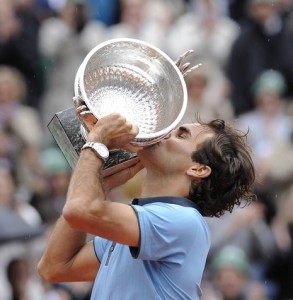
Federer finally claimed the career Grand Slam with a win at the French Open.
Federer bounced back big, however, at Madrid where he defeated Nadal definitively in the finals, 6-4, 6-4. This was a monstrous win for Federer, coming as it did just before the start of the French Open.
It was Federer’s second win on clay against Nadal in 11 tries and marked Nadal’s fifth defeat in 155 matches on clay going back to 2005.
Nadal appeared listless and flat in the final. Federer only flashed a few nerves in the final game, but he took the victory in Madrid and ran with it all the way to the French Open final, where all of his dreams would shortly come true.
Across the net from him on a cold, drizzling final Sunday afternoon was Swede Robin Soderling who had done the impossible deed—beaten Rafael Nadal during the fourth round on the red clay of Stade Roland Garros where the Spaniard had never lost.
It was only fitting that the man who defeated Nadal face Federer in the final.
With Soderling stunned and stilled by the occasion, it was not surprising that Federer ran away with the first set, winning it 6-1. But it was not simply the occasion that crushed the Swede, it was Federer’s game.
The Swiss remained relentless and pummeled Soderling with 16 aces along with seven service winners. He added drop shots and threw in speed and accuracy.
Federer was not going to be denied. This, he reasoned, was his best shot at winning the elusive French crown and Federer was about to realize his dream.
In the end he was not denied. He captured his first French Open championship, his 14th Grand Slam title and owned his first-ever career Slam.
Federer acknowledged that his game had been missing in action, but now it was back, and so was the Maestro, strumming on all chords, ready to reclaim his place at the top of the men’s game.
Leg No. 3—2009 Wimbledon.
Federer skipped his normal grass warm-up at Gerry Weber after his triumphant French Open. At the same time, 2008 defending champion Nadal withdrew from Wimbledon citing knee injuries that required prolonged rest.
As Wimbledon 2009 neared, questions surfaced: (1) Would Federer win his 15th Grand Slam at Wimbledon, where he won his first, or (2) would Murray finally win his first major tournament?
With Nadal absent, Federer was seeded No. 1 and gifted another huge opportunity. The Swiss, in addition to claiming slam No. 15, could regain the No. 1 world ranking and claim his sixth Wimbledon title.
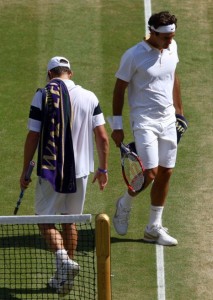
Federer and Andy Roddick played an epic final at Wimbledon.
Federer could cement his place atop the tennis record books. It was to be a monumental tournament in many ways starting with the new retractable roof over Centre Court operational for the first time during the summer of 2009.
Federer made it again to his seventh Wimbledon final where he met American Andy Roddick for the third time in the decade, doing battle for the Centre Court championship.
It became an epic—a 77-game final where Roddick’s only break of serve came in game 77, and that cost him the set (16-14), the match, and his best chance ever to win the Wimbledon crown.
Federer won his 15th Grand Slam, reclaimed his No. 1 ranking, and captured his sixth Wimbledon championship.
The record book groaned under the weight of Federer’s added accomplishments.
Leg No. 4—2009 U.S. Open and Indoor
With his plate filled to overflowing, Federer headed into the U.S. hardcourt series with everything left to gain.
Another win at the U.S. Open would give him six consecutive titles—the best in the modern era. It would garner Federer slam No. 16 and a two-slam lead over Pete Sampras. It would mean another year of winning three out of four majors and guarantee his No. 1 ranking at the end of 2009.
Entering the Roger’s Cup at Montreal, Federer had not played since Wimbledon. He went out in the quarterfinals to Jo-Wilfried Tsonga, 6-7, 6-1, 6-7. This was a strange loss because Federer was up 5-1 in the third set before his game collapsed.
However, he bounced back quickly in Cincinnati, winning the tournament. In the process he defeated Murray in the semifinals and Djokovic in the finals.
It was a rewarding victory and a good omen going into the U.S. Open, where he would be seeded No. 1 and his old nemesis Nadal would be seeded No. 3 as Murray absconded with the No. 2 seed.
Unfortunately for Federer, the magic dust would fall on the other side of the net this time elevating del Potro, the towering Argentine, to the tip-top of his game, sweeping away Federer’s hope of a sixth consecutive championship in New York. Del Potro won a lengthy battle, 6-3, 6-7, 6-4, 6-7, 2-6.
Federer could not close out the Argentine, given numerous opportunities. In the fifth set, the Swiss’ normal composure melted and he rushed points, trying to hard to hit winners and shorten points. He lost.
It was a stunning win for the Argentine—the first man to defeat Federer in a major final besides Rafael Nadal.
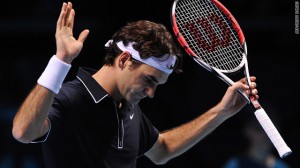
Federer played well enough in the final months of 2009 to finish the year as the top ranked player in the world.
Federer played Davis Cup for Switzerland to ensure their continued presence in the World Group. After accomplishing that, the Swiss No. 1 went on holiday, withdrawing from the 2009 Japan Open and the Shanghai ATP Masters 1000.
Federer returned to play in his hometown tournament, the Swiss Indoor at Basel. He lost, 4-6, 6-4, 2-6, in the finals to Djokovic, who was having an extremely successful indoor season.
At the Paris Masters Federer received a first round bye—then he lost in the next round to Julien Benneteau, 3-6, 7-6, 6-4. His bad luck at this Paris Masters event continued.
At the 2009 ATP World Tour Finals Federer defeated Verdasco and Murray which secured him his year-end No. 1 ranking. Although he lost to del Potro in his last round robin contest, Federer had enough points to secure a spot in the semifinals.
There he met and was defeated by Nikolay Davydenko—who went on to win the championship by defeating del Potro in the final.
The next leg—2010
Federer begins competition for 2010 at Abu Dhabi where he will play against Nadal, Davydenko, Soderling, Wawrinka, and David Ferrer, who is replacing Tsonga in the lineup. After that, Federer and Nadal will both play in Qatar at the Exxon Mobil Open.
Competition in Kooyong is still also a possibility for Federer leading up to Melbourne.
The Australian Open is where the winner is anyone’s guess—as is always the case. It is what makes the tournament “Down Under” so vital and so compelling.
One thing is certain—there exists more parity at the top in the men’s game. Everyone wonders who the surprising finalist will be this year.
Federer is entering another level on the continuum of his long, illustrious tennis career. It appears that his serve is better than ever, when he is on. His talent and his experience are enormous assets that the Swiss employs at will.
What the great man needs to reconcile is his desire to compete and his ability to win. There is something to be said for the maxim that “practice makes perfect.” In order for Federer to play so well for so long at these ridiculously high levels, he must have drilled his arsenal of shots over and over again until reaction was instinct wired in as total recall.
This level of dedication is a must for today’s champions.
Nadal practices at the same level except that his style of play is more physical and rigorous—hence, his body was unable to withstand the constant pounding. Federer’s style of play, however, is more forgiving on his extremities.
Because Federer is doing what his body requires by resting more and playing less, he is losing his mental edge because the total recall is not always there and he loses confidence and calm. This causes him to force the action.
Often he loses his ability to play his opponent as he should when anxiety replaces instinct.
For the most part, Federer’s experience and his skill will allow him to win; when pushed and stretched in a match, though, he will falter more and lose more often.
That does not mean that Federer will not rise to the top during majors. The majors allow Federer a chance to play his way into match form.
Adjustments should be made going forward, and it will be interesting to see if Federer can find an answer and reclaim his deep-seated confidence and his mental edge. 2010 is open court—all you have to do is win…